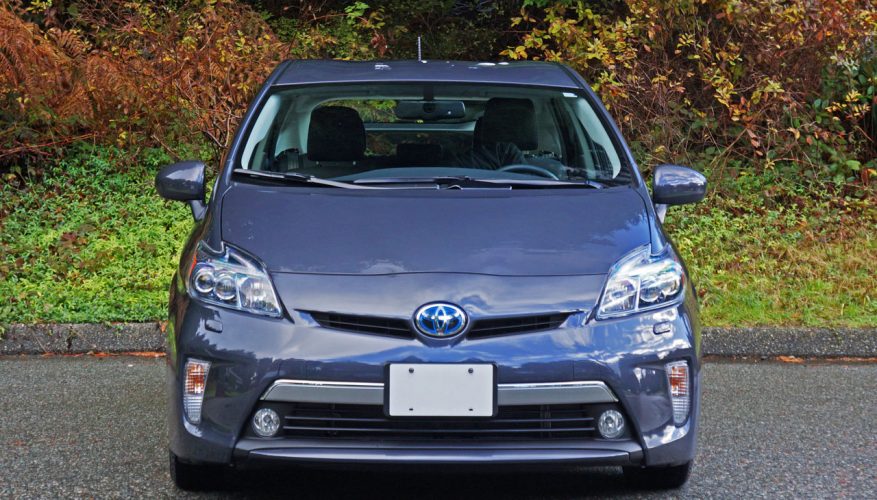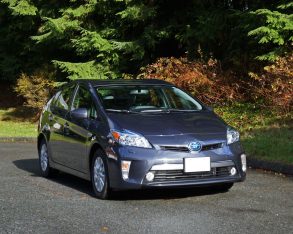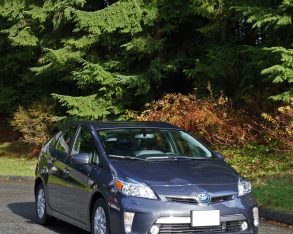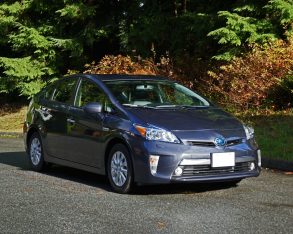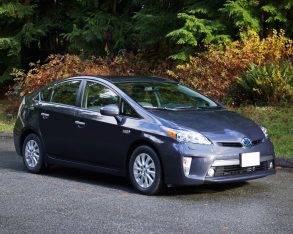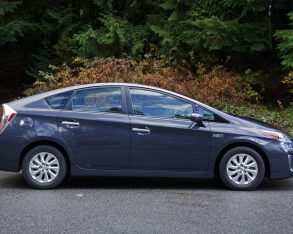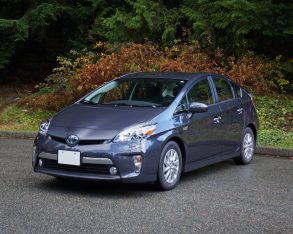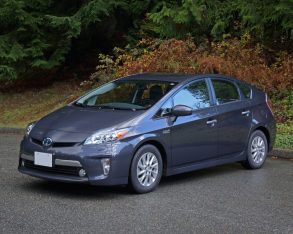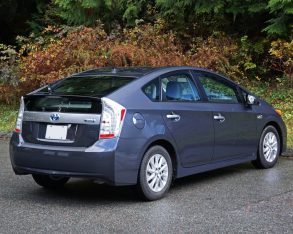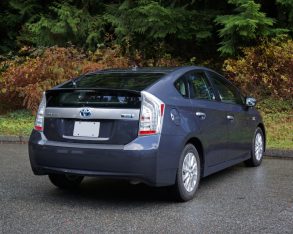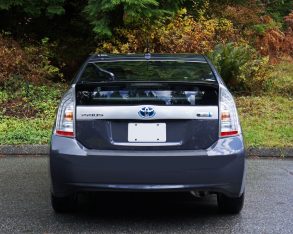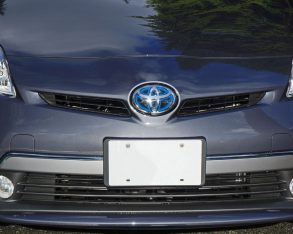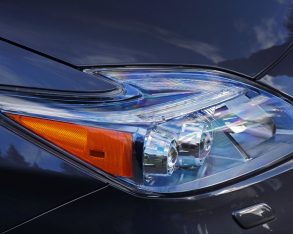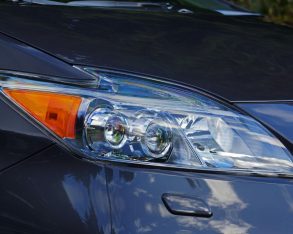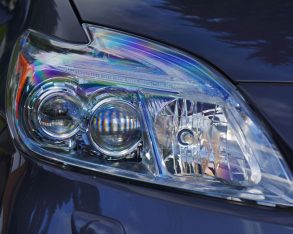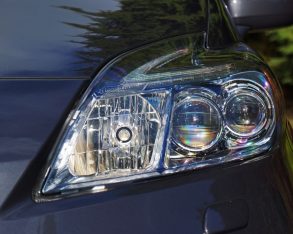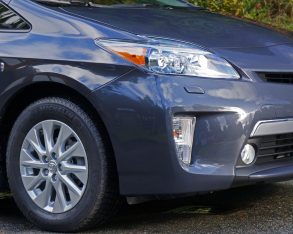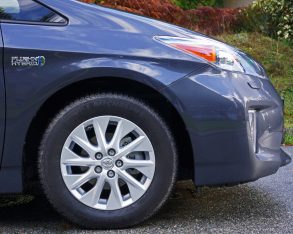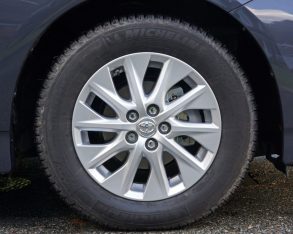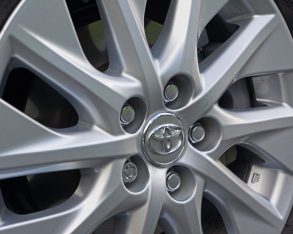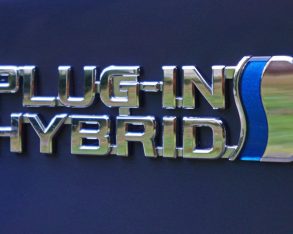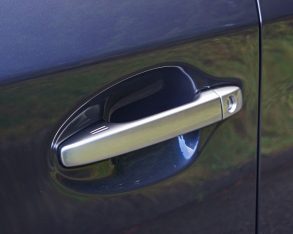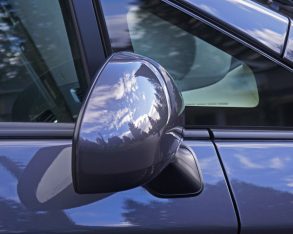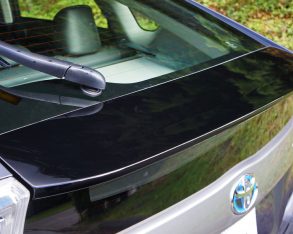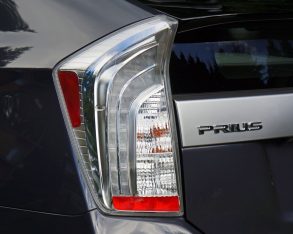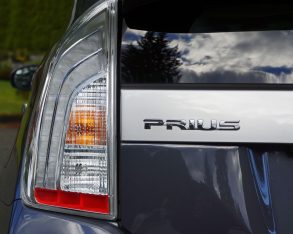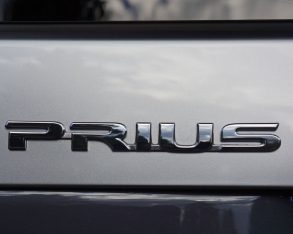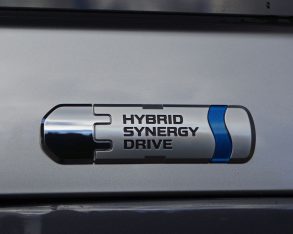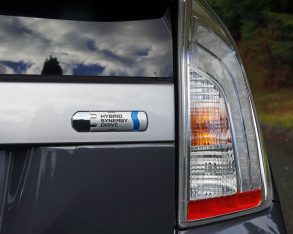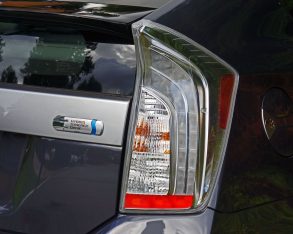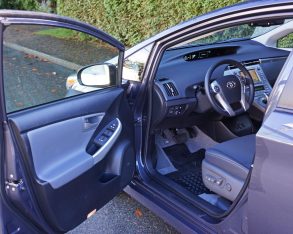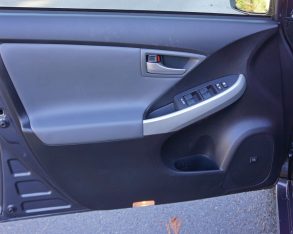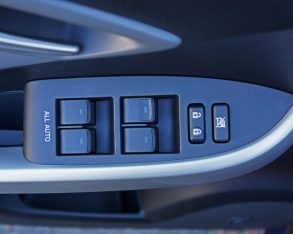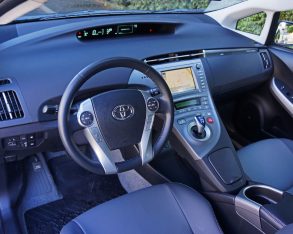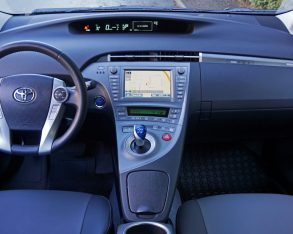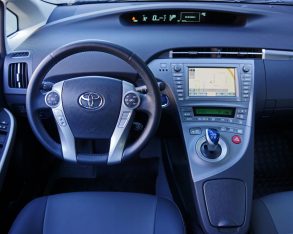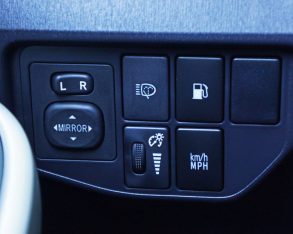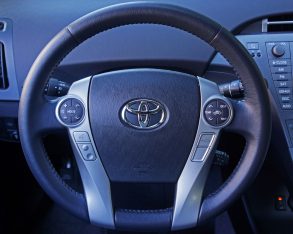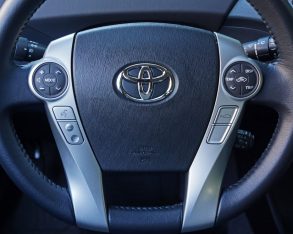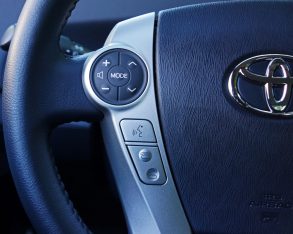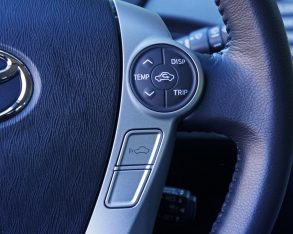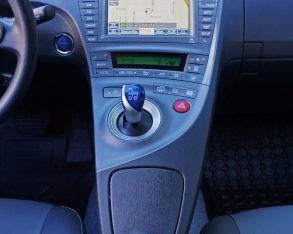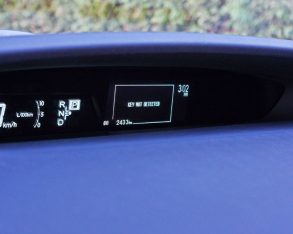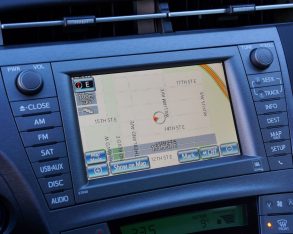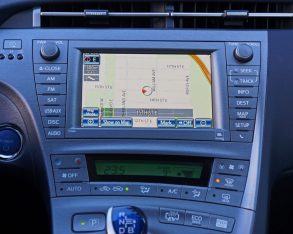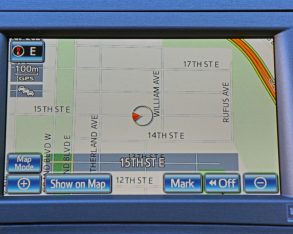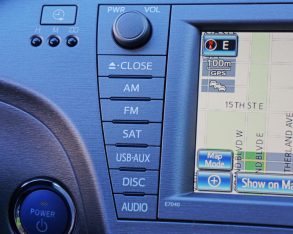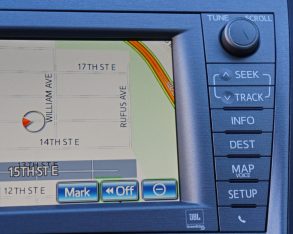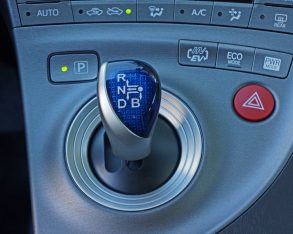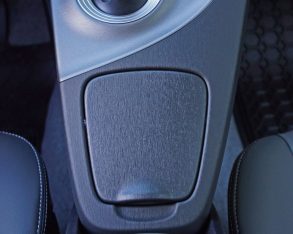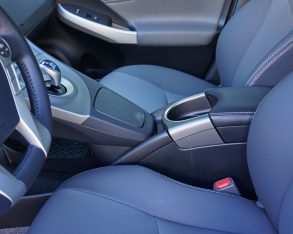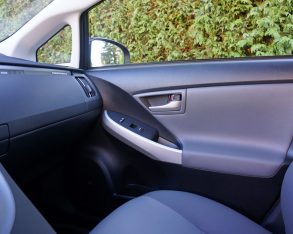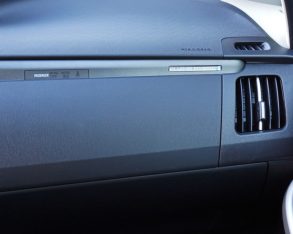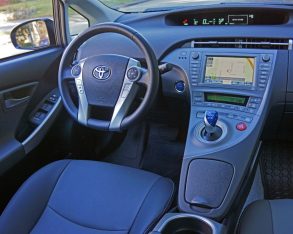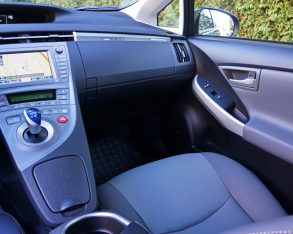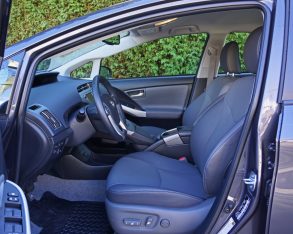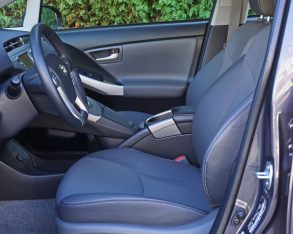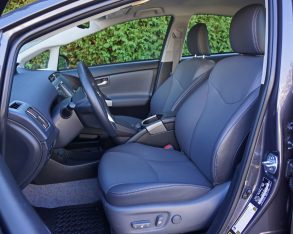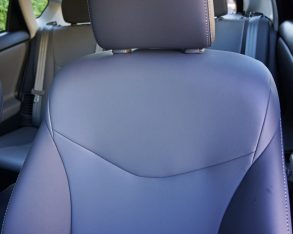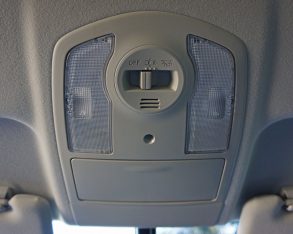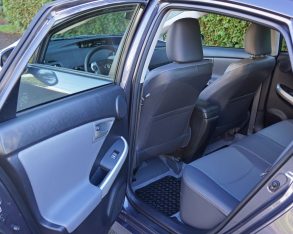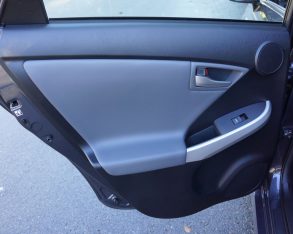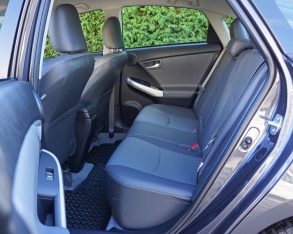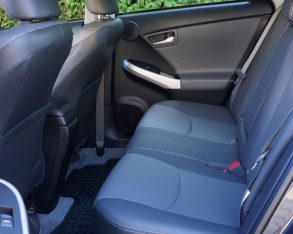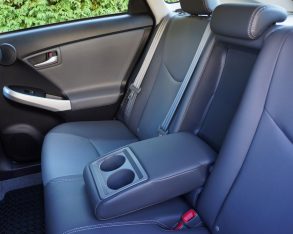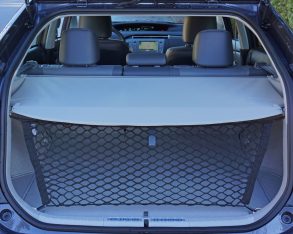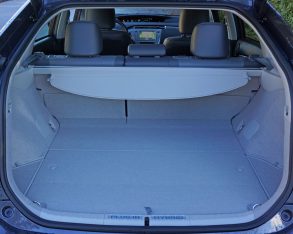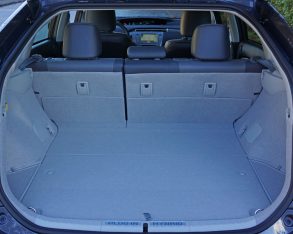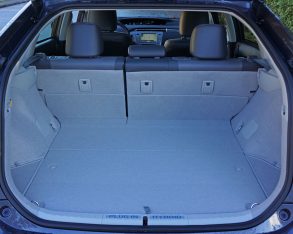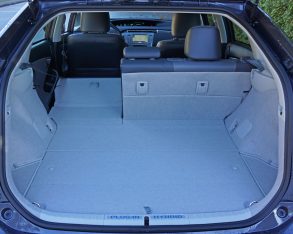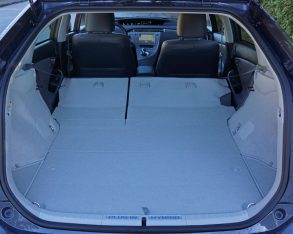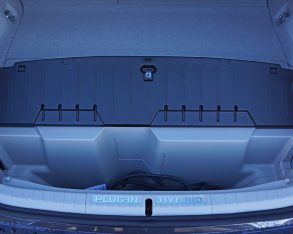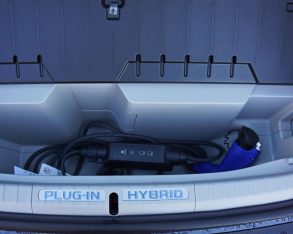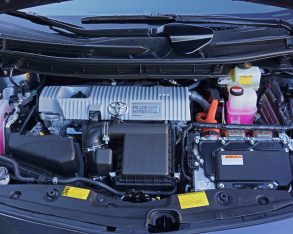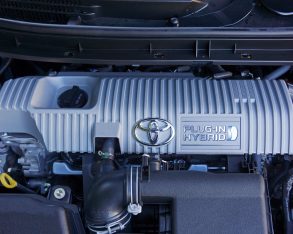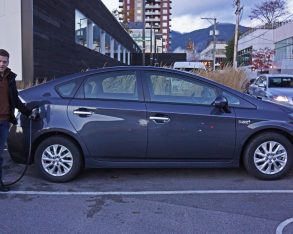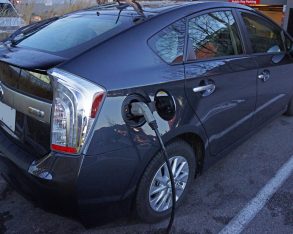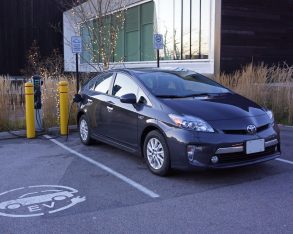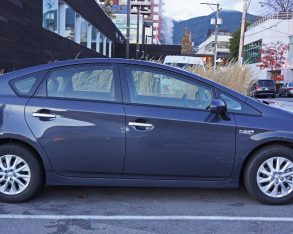If a Prius Plug-in Hybrid were to pass you by, would you know? Serious electric car aficionados are the only ones who would take
 |
| Photo: Karen Tuggay, Canadian Auto Press |
notice of the three differentiators including a nice bit of bright metal trim across the lower grille, new "Plug-In Hybrid" logos and a stylized chrome plug on the backside “Hybrid Synergy Drive” logo, and a second “gas cap” lid on the rear passenger’s side. That’s where you plug it in with the specially designed extension charger cord via a household socket, with a household/apartment charge station if you happen to have one at your disposal, or numerous free charging stations found all over town. The lid on the driver’s side is like most Prius models, where you refill the gas tank.
Why I love the Prius Plug-in, or PHV for short, starts off with the same reason I like all other plug-in vehicles: they’re really cheap to operate and very cool in an ultimately green sort of way. What turns the like into love with the Prius PHV is that it can be driven for free most of the time and doesn’t ask you to make a single
 |
| Photo: Karen Tuggay, Canadian Auto Press |
compromise over the already large and accommodating regular Prius. It seats five as capaciously as a mid-size sedan and stows as much gear as the more conventional Prius hybrid, up to 612 litres (21.6 cubic feet) behind the 60/40-split seatbacks and a compact SUV-like 1,121 litres (39.5 cubic feet) when you lay those seats flat. What’s more, it’s a comfortable easy car to drive no matter whether you’re tooling around town or zipping down the highway, scoots along surprisingly quick when called upon and takes to the curves with greater agility than you’ll likely believe until you try it for yourself.
Then
 |
| Photo: Karen Tuggay, Canadian Auto Press |
again, all of these attributes shouldn’t be too difficult for you to believe after considering just how shockingly successful the Prius has been since inception. Toyota has sold more Prius models in the car’s 18-year lifespan than all other hybrids put together, and the car’s overall dependability is now the stuff of legend, some taxicabs having driven more than a million miles, let alone kilometres. And don’t just take my word for it, do a search for yourself. The one that’s over the million-mile mark is in Vancouver, BC, that car bypassing 1.5 million kilometres in 2012 and still being used today. There’s another taxi in Vienna, Austria that’s exceeded 1 million km, and numerous others that have passed the half million mark. Is there another car on the road that can make such claims, hybrid or not? Over the years there have been one-off storied Volvos, Mercedes diesels, BMWs and the like that have achieved similar feats, and I’m sure people have driven Corollas and Camrys past these mileposts, but the sheer number
 |
| Photo: Karen Tuggay, Canadian Auto Press |
of Prius examples available via a cursory search shows that it has a true certifiable history of reliability. The Prius Plug-in simply builds on that history, with a larger motive battery for longer distance EV mobility.
The production version of the Prius Plug-in Hybrid was released in 2012 as a 2013 model, and we covered it despite being covered in large promotional decals from nose to tail. That multi-blue-hued body skin was part of the PHV’s roll-out plan, necessary for drawing attention to this new model within Toyota’s burgeoning Prius ranks, and while it remains a slower seller compared to the regular Prius, just having a plug-in variant is critically important for an automaker that almost singlehandedly defined the hybrid electric market (Honda was there, but its earliest entry wasn’t well received). Along with that decaled version we also covered
 |
| Photo: Karen Tuggay, Canadian Auto Press |
a nice simple metallic blue coloured PHV for the 2013 model year, and then last year we covered two in different colours but identical states of trim, both decked out with the full load Technology Package.
That’s how Toyota fitted the 2015 Prius Plug-in Hybrid I recently tested, this one wearing Winter Grey Metallic paint just like one of the models we covered last year. Yes, it would be nice if Toyota mixed up our test cars’ colours each year, the Prius PHV offering four additional hues including Clearwater Blue Metallic (the colour we tested last year and the year prior), Classic Silver Metallic, Sea Glass Pearl (a light green), and Blizzard Pearl (off white with a pearlescent sheen, and the shade of a regular Prius I recently covered), the latter costing an extra $255 but well worth the coin in this writer’s opinion.
The Prius PHV’s interior is the same mixture of black, dark grey and medium grey no
 |
| Photo: Karen Tuggay, Canadian Auto Press |
matter the exterior colour chosen, and it all comes together nicely for a pleasing look. Like all Prius models, the Plug-in gets a digital set of primary gauges positioned on the top centre of the dash, incorporating a speedometer, fuel gauge, gear selector readout, odometer, digital clock and trip computer, which leaves nothing ahead of the steering wheel but a bit of dash and windshield. That steering wheel incorporates two sets of touch tracer controls, the left side for audio functions and the right for remotely setting the automatic climate control temperature and recirculating air, as well as display and trip computer functions, while a couple of buttons on the left portion of the hub are for voice activation and answering/hanging up calls, and one on the right side for the dynamic cruise control.
Below
 |
| Photo: Karen Tuggay, Canadian Auto Press |
the primary gauges is a larger seven-inch full-colour infotainment display surrounded in audio switchgear and, thanks to the technology package, navigation system access buttons, while below that is an interface for the automatic climate control system I mentioned a moment ago.
Following the centre stack downward, my favourite Prius design detail is an electric blue digital-patterned gearshift knob that should find its way into an industrial art museum like the Smithsonian or better yet, the Pennsylvania Museum and School of Industrial Art (PMSIA), to be revered for its aesthetic design as well as its ingeniously forward thinking engineering. What makes that shifter work differently than the norm is the way you select its “gears”. It’s ultra simple
 |
| Photo: Karen Tuggay, Canadian Auto Press |
in that “D” is a pull to the left and then down, “R” is a pull to the left and then up, “B” or battery recharge mode is a direct pull rearward, and “P” is a separate button found just to the left of the gear lever. The way it operates is the opposite of so many other electronic transmissions that are trying to duplicate the feel of a conventional automatic, in that the Prius’ CVT makes no bones about its unorthodox electronic operation, seeming to brag about its uniqueness instead.
And it should. As noted, the Prius has been almost universally praised and accepted
 |
| Photo: Karen Tuggay, Canadian Auto Press |
as the benchmark of hybrids. Its Hybrid Synergy Drive system has tracked the most distance amongst hybrid drivetrains for the most acquired data of any automaker’s gasoline-electric propulsion system and therefore Toyota should be able to keep its lead in the green game far into the future – you and I aren’t the only folks eagerly awaiting all that lays in store for the next generation Prius. For now the Prius PHV incorporates the most advanced Hybrid Synergy Drive setup yet, with a higher-capacity 4.4-kW/h (207.2-volt) lithium-ion motive battery under the rear cargo floor instead of the usual 1.3-kW/h nickel metal hydride unit. The rest of the drivetrain is status quo Prius, including the identical 1.8-litre, 98-horsepower high-compression Atkinson-cycle gasoline engine and CVT transmission, the same electric traction motor sending torque down to the front wheels in either electric-only EV or electric-assist mode, and the same regenerative brakes charging the motive battery back up when the transmission is in “B” mode, the car is slowing down or you’re applying the brakes.
What
 |
| Photo: Karen Tuggay, Canadian Auto Press |
this means is that the Prius’ EV-only range increases from approximately 1.5 km to about 24 km, and the speed the EV system can operate at rises from about 20 km/h to 100 km/h, or in other words you’ve got a fully capable electric car that doesn’t require any internal combustion engine (ICE) assistance until the battery is depleted, at which point it’ll run continuously until the 40-litre (8.8-gallon) gas tank is depleted (not recommended, of course). As you might expect, if you run it at 100km/h you’ll deplete the battery much quicker than if you’re light on the throttle while remaining at city speeds, so the slower way to work might be advantageous if you’d rather not pay for gas and/or don’t want to make as large of a dent on the environment.
With a number of charging stations near my home I was able to keep the Prius PHV topped up with electrons most of the time, hardly ever dipping into the “reserve” gas tank. This made my week with the PHV one of the least expensive on
 |
| Photo: Karen Tuggay, Canadian Auto Press |
record, a total of $4 in fuel required before returning it to Toyota. Actual claimed fuel economy numbers are 4.7 L/100km in the city, 4.8 on the highway and 4.7 combined when using both electric and gasoline power in hybrid mode, or 2.6 Le/100km city, 2.3 highway and 2.5 combined in EV mode – alternatively the latter could be zero if your commute is short and you don’t spend much time driving at regular highway speeds.
Incidentally, Natural Resources Canada cited seven 2015 Toyota vehicles as having best-in-class fuel-efficiency, which is more than any other manufacturer, while this is the 15th year in a row that a Prius has been on the list, and we’re not even talking about the PHV.
Just the same, this is the point where many pundits question the real-world merits of
 |
| Photo: Karen Tuggay, Canadian Auto Press |
a plug-in vehicle as compared to a conventionally powered model with decent gas mileage. The 2015 Prius Plug-in is not cheap, with a starting point of $35,805 plus $1,620 for freight and pre-deliver preparation for the well-equipped standard package and $41,040 when the Technology Package is added on, which is $6,750 more than the regular Prius with its Technology Package. That latter number represents a lot of fuel, and if you were to compare either Prius to an equivalently equipped car without any driveline electrification the price gap would only increase. This is where you need to decide if you’re looking to go green to save money and/or save the environment, or if you’re like me and, while appreciating a bit of both, are more of a technology geek. I love driving around on silent electric power, the novelty of plugging it in to recharge and chatting with zealous EV users at recharging stations. It’s a different kind of performance than the usual horsepower and handling provided by sports cars
 |
| Photo: Karen Tuggay, Canadian Auto Press |
and sport sedans, but the fun had behind the wheel and then the camaraderie with likeminded enthusiasts is similar.
Some provinces offer rebate programs to buyers of hybrids and plug-in vehicles, which can dramatically offset the initial cost of purchase. Ontario offers a $5,000 rebate for vehicles that qualify for its green license plate, the Prius PHV being among that lot, while the Quebec government offers a similar amount, but that program is supposed to be cancelled after 2015. BC already cancelled its $2,500 rebate last spring, which means that PEI is now a greener Canadian province (with respect to cars) as its residents can still qualify for a $3,000 rebate. These handouts may be cancelled at any time, of course, so I’d recommend taking advantage as soon as possible if you’re living in any of these jurisdictions.
From
 |
| Photo: Karen Tuggay, Canadian Auto Press |
a driving perspective the Prius PHV performs just like any other Prius, albeit silently more often. Acceleration is snappy, especially on takeoff as 100-percent of the electric motor’s 153 lb-ft torque comes on immediately and the PHV is only 55 kilos (121 lbs) heavier than the regular Prius at 1,435 kilograms (3,163 lbs) so there’s not a lot holding it back. You can press a “PWR Mode” button just above the shift lever for those moments when you need to get away even quicker, though I wouldn’t do that often if you plan on going any distance in EV mode. Rather, a button just to the left selects “Eco Mode” and an “HV/EV” button beside that will select electric-only propulsion if you have enough juice in the battery. Like the regular Prius the PHV is a great around town cruiser and stable on the highway while, as mentioned, more adept at managing corners than you might think. All seats are comfortable and
 |
| Photo: Karen Tuggay, Canadian Auto Press |
the interior is open and airy with plenty of passenger room front and back.
I noted before that my tester featured the Technology Package, which means that along with the larger seven-inch infotainment display and AVN premium navigation system it also included superb sounding eight-speaker JBL audio, an eight-way power adjustable driver’s seat, auto-leveling LED headlamps, headlamp washers, fog lamps, Toyota’s leather-like SofTex upholstery with light grey contrast stitching for a sporty look, dynamic radar cruise control and a pre-collision system.
All of these upscale features were added to the model’s standard feature set that includes Toyota’s Smart Key proximity-sensing keyless access with pushbutton ignition,
 |
| Photo: Karen Tuggay, Canadian Auto Press |
automatic climate control, AM/FM/CD/MP3/WMA compatibility along with aux and USB inputs for the stereo, Bluetooth hands-free phone connectivity and music streaming, satellite radio, a backup camera system, multi-information display, an ECO Drive monitor, an auto-dimming electro-chromatic rearview mirror, tilt and telescopic steering, cruise control, dual power adjustable and heated exterior mirrors, power windows with auto up and down all-round, variable intermittent wipers and an intermittent rear wiper, scuff plates on the doorsills, carpeted and all-season floor mats, an overhead console with a sunglasses holder, a cargo cover, LED taillights, 15-inch alloy wheels on 195/65R15 all-season tires, four-wheel disc brakes with ABS, emergency brake assist and electronic brake-force distribution, traction and VSC stability control, Toyota’s Smart Stop Technology (SST) that cuts power to the engine
 |
| Photo: Karen Tuggay, Canadian Auto Press |
during emergency braking, tire pressure monitoring, active front headrests with whiplash protection, front seatbelt pre-tensioners and force limiters, plus seven airbags including one for the driver’s knees.
Lastly, but important for respecting the environment the Prius PHV intends to protect, it’s one of the most recyclable production cars available, while many of its materials are made with alternative ingredients too. Ingredient is the key word because Toyota sources its eco-plastic from plant-sourced matter instead of petroleum, while the seat foam is made from soybeans. And if you’re wondering why the top-line Technology Package covers the seats with SoftTex instead of leather, well then you just haven’t read enough info on how much harmful methane is produced by the world’s bovine population, let alone how much feed they
 |
| Photo: Karen Tuggay, Canadian Auto Press |
require, ranchland needed, etcetera. The car’s cabin doesn’t incorporate any exotic hardwood for the same reasons.
All of Prius’ goodness helps it to hold its value better than most other vehicles, the iconic hybrid achieving Canadian Black Book Best Retained Value Awards for the last three years running. Incidentally, Toyota Canada has won more CBB awards than any other manufacturer, not to mention more ALG Canadian Residual Value Awards.
In either base form or with the Technology Package as tested, the 2015 Toyota Prius Plug-in is a well equipped car that’s comfortable, accommodating, enjoyable to drive and unsurprisingly frugal on fuel, while the novelty of plugging it in and driving it silently around town for miles, not even needing to fill it up for days or possibly ever, is priceless.
©(Copyright Canadian Auto Press)





















